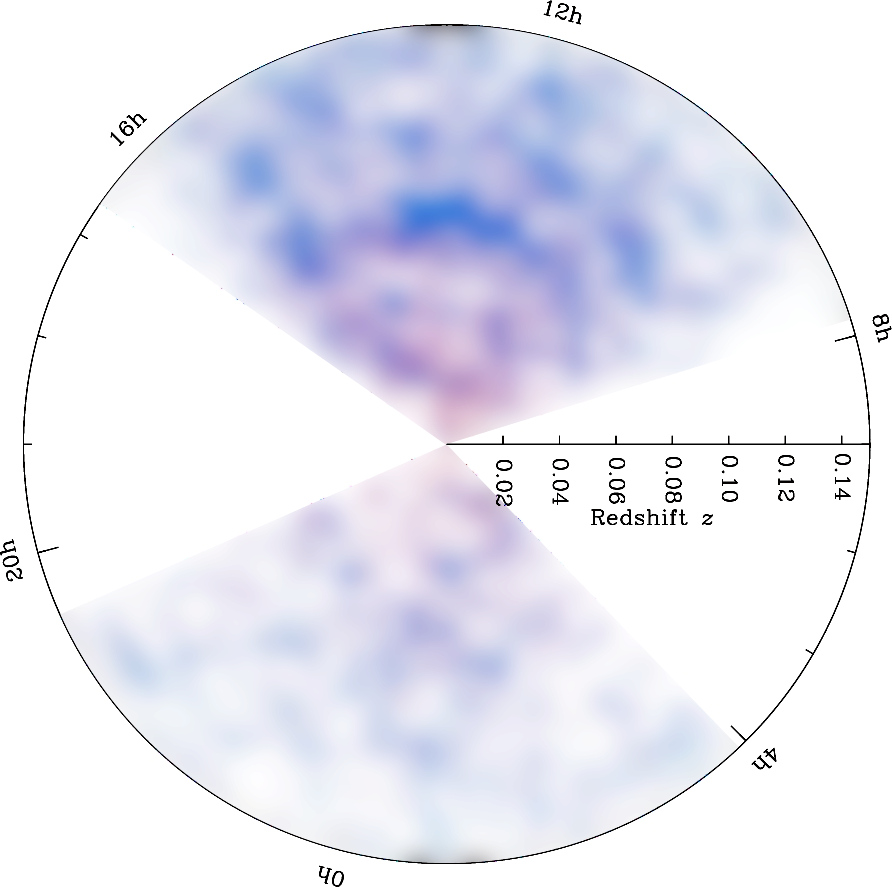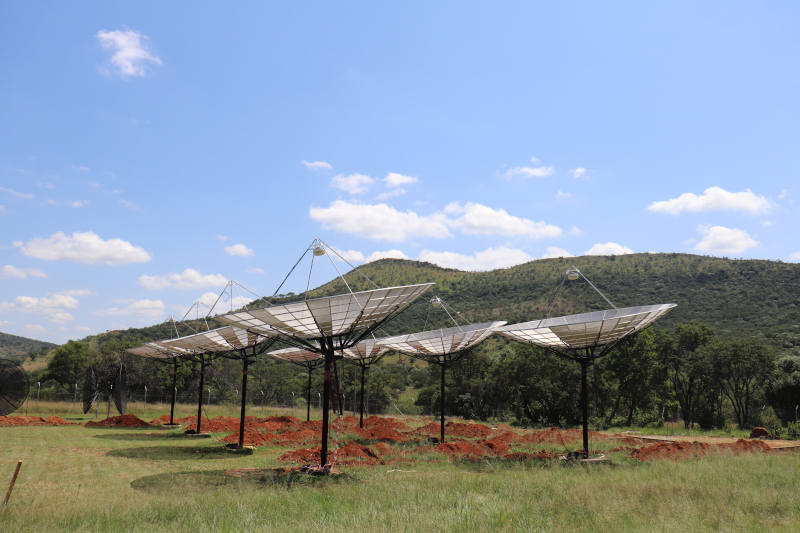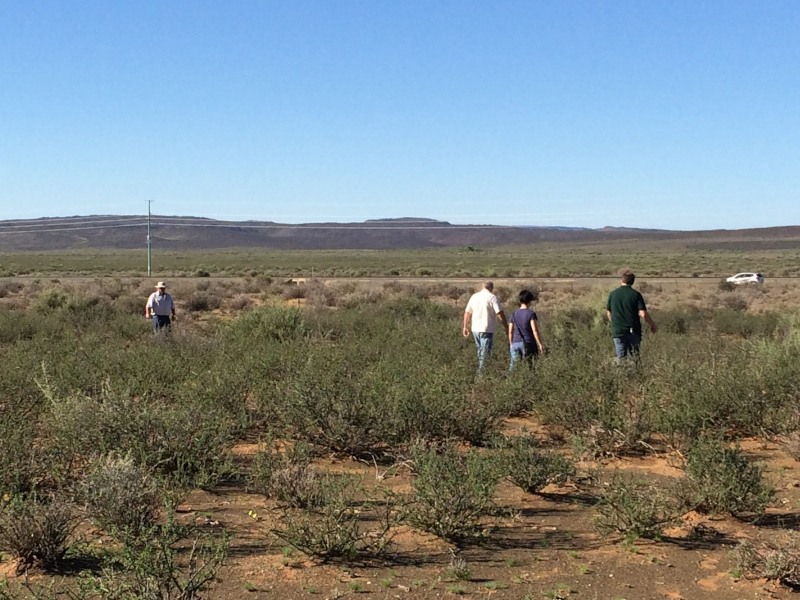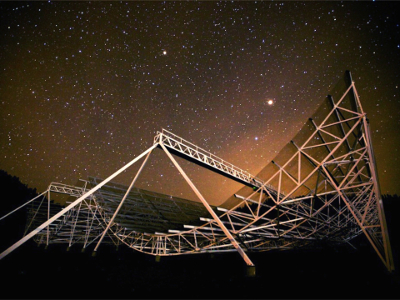Research: Intensity Mapping
Intensity mapping is a powerful and relatively new technique for mapping huge volumes of the Universe. Read more about what intensity mapping is and what I am working on below.
On This Page: What is Intensity Mapping? • Hydrogen Intensity and Real-Time Analysis eXperiment • Previous Work (Canadian Hydrogen Intensity Mapping Experiment)
What is Intensity Mapping? [⯅ Top]
In cosmology we are often interested in the large scale structure (LSS) of the Universe, that is, how its density varies on extremely large scales. For instance, one popular scale (that of the σ8 parameter) is around 11.5 megaparsecs, or roughly 37 million light years. On these scales, even galaxies are tiny—our own Milky Way is ‘only’ about 100,000 light years across. Models of cosmology make precise predictions about the nature of LSS; furthermore, baryon acoustic oscillations have imprinted a specific signature on the LSS on scales of about 150 megaparsecs (500 million light years) that can be used to determine how fast the universe is accelerating. (See my Baryon Acoustic Oscillations Tutorial for more about this.)
One way to study the LSS is to measure the distance and positions of lots and lots of galaxies and look at how they clump together on average. However, it takes a long time to do this! Intensity mapping is a technique to make maps of large scale structure more quickly and efficiently. Consider the following diagram:


Image by M. Blanton and SDSS (CC-BY-4.0); colours inverted (left) and then Gaussian blurred and white balanced (right).
The right-hand image above shows that if you use bigger ‘pixels’ in your measurement of the sky, such that each pixel has lots of galaxies in it, you can still see the large-scale structure. ‘Intensity mapping’ does just that, by measuring the total intensity from all the galaxies within its large pixels—not using visible, light, however, but the radio portion of the spectrum.
Neutral hydrogen gas emits light at a wavelength of 21 cm. By measuring the total intensity of this 21 cm emission, we can infer the relative number of galaxies doing the emitting, and build up a picture like the cartoon in the right panel above. Furthermore, because we know the precise wavelength of emission, we get the redshift to the source of the emission for free, simply from the wavelength of reception. Thus, you can make a 3D map of the Universe using intensity mapping.
Of course, like any scientific measurement, there are challenges. You need very sensitive instruments—for CHIME, the amount of energy received from all the 21 cm radiation from galaxies over one year is about equivalent to lifting a paperclip one millimetre off the ground! Furthermore, our own galaxy emits a lot of radio signal—a lot more than comes from other galaxies—which you need to carefully subtract to get to the signal you are interested in. But those of us working on the experiments below believe that we can deal with such challenges to access an exciting new probe of cosmology.
See also:
Hydrogen Intensity and Real-Time Analysis eXperiment [⯅ Top]

Image by HIRAX
One of the biggest puzzles in contemporary cosmology is the fact that not only is the Universe expanding, but that it is speeding up. Something is counteracting gravity's attraction. Typically, this mysterious force is called ‘dark energy’, but this is little more than a name for our ignorance. Learning more about dark energy is headline scientific goal of the Hydrogen Intensity and Real-Time Analysis eXperiment (HIRAX).
HIRAX will consist of a large array of about 1000, six metre radio dishes located in the Karoo of South Africa. By working all together, the dishes yield a huge collecting area that will give us the high sensitivity and sufficient angular resolution we need to detect the baryon acoustic oscillation signal and measure how fast the Universe is accelerating—a key piece of empirical science that will help us figure out what dark energy, the mysterious field that today makes up about 70% of the Universe, might actually be. The Karoo is an ideal location for HIRAX because there is very little man-made radio signal to interfere with our measurement. The project is led from the University of KwaZulu-Natal but is an international collaboration that includes myself and others at the University of Toronto.

Image by HIRAX
In addition to studying the expansion of the Universe, HIRAX will be an excellent instrument for lots of other science. It will be able to see fast radio bursts (FRBs), a highly energetic class of events that is currently poorly understood. It will be well-equipped to study pulsars and will undoubtedly discover new ones. Further, although radio emission by our own galaxy is a contaminant for other science, it is also something worth studying in its own right. Finally, it is not uncommon for huge new telescopes like HIRAX to discover new, unexpected phenomena.

It has been quipped that to do modern astronomy you need a large computer with a mirror attached to it. For HIRAX the hyperbole is only slight. While there will be a huge amount of hardware—roughly a thousand dishes, each with antennas, amplifiers and cables—the amount of computing power required to combine all their signals many millions of times per second is enormous. The amount of data that is received is more than we can reasonably store, so we need to carefully compress the data before it is recorded and analysed. Such compression requires knowing the characteristics of the instrument, so it is an interesting blend of computer programming and instrumental calibration. This is an area of the experiment that I will be helping to lead.
Over the next few years, the array of dishes will be progressively be built up. HIRAX will share much of the technology developed for CHIME, which I have worked on in the past and is described below.
External Links of Interest
- Official HIRAX Website and Wikipedia article
- PhysicsWorld article on dish prototypes
Previous Work [⯅ Top]
Canadian Hydrogen Intensity Mapping Experiment [⯅ Top]

Photo by Andre Recnik.
As mentioned above, HIRAX is highly complementary to another radio telescope: the Canadian Hydrogen Intensity Mapping Experiment (CHIME). The latter has very similar science goals, but is located in the northern hemisphere. Furthermore, it has a significantly different—and quite unusual—dish design: rather than many circular dishes, it consists of four, 100-metre-long and 20-metre-wide cylinders, populated with a total of 1024 dual-polarisation radio antennas.
CHIME has already produced exciting science through its discovery of several fast radio bursts, including one that is regularly periodic. (Note that I was not involved in these papers.) CHIME was awarded a Governor General's Innovation Award in 2020.
If you'd like to hear about CHIME in Italian, here is my attempt.
External Links of Interest
- Official CHIME Website and Wikipedia article
- CBC article on the repeating FRB discovered by CHIME
- Scientific American article on CHIME's first fast radio burst detection
- Articles on CHIME general science in The Globe and Mail, CBC News and Nature
- CHIME in Italian
- CHIME on Quirks and Quarks